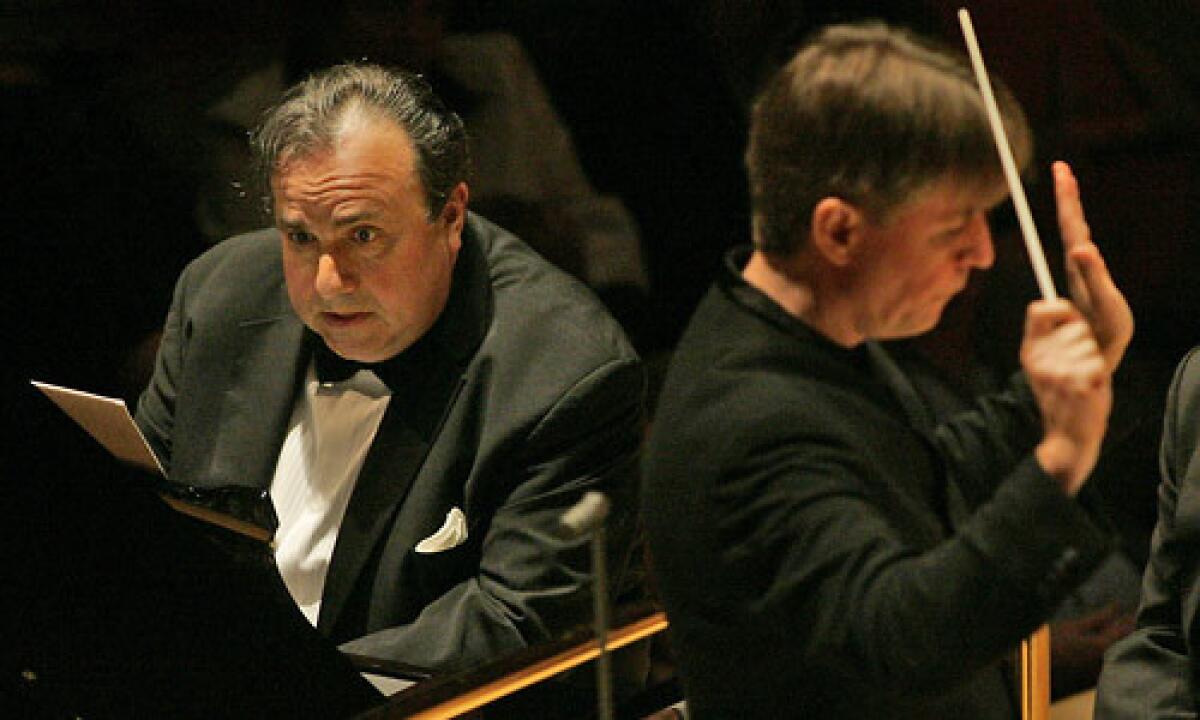Bronfman plays Salonen’s Piano Concerto

- Share via
On Feb. 1, 2007, the New York Philharmonic premiered Esa-Pekka Salonen’s Piano Concerto, his most ambitious orchestral score. The Big Apple’s skeptical concert-goers and critics, proudly sporting their late-model flashiness detectors, responded with surprising (and evidently surprised) enthusiasm. The composer conducted. The orchestra, a very great ensemble in music it has played a million times, was impressive, barely over its head.
Yefim Bronfman, the herculean Russian pianist for whom the concerto was written, sweated bullets at the premiere and complained to any reporter who would listen about just how outrageously difficult the solo part was -- and how unfairly late the composer, a close friend, had been in delivering the finished score. No one took him seriously; he was a sensation.
Finally, 16 months later -- after further performances of the concerto by Salonen and Bronfman in London and Chicago -- E-P has called home. He and Bronfman offered a breathtaking account of the concerto to close the Los Angeles Philharmonic’s program, the last of the season, Thursday night in Walt Disney Concert Hall.
The concerto has not been universally lauded. Martin Bernheimer panned the premiere in the Financial Times, and the British critics followed his lead in their unanimous dismissal of the work as warmed-over Ravel and Rachmaninoff after it was played in the British capital at the Proms last summer (although a lot of cheers from the audience could be heard on the BBC broadcast). Chicago’s response was apparently warm, not hot.
Finishing touch
The heat, however, was up in Disney. Deutsche Grammophon is on hand with dozens of microphones set up on stage to record the four performances of the concerto for CD. The Philharmonic, which is concluding six weeks of memorable concerts with Salonen, claims a prerogative when it comes to its music director’s music. A Salonen orchestral score never seems quite finished until it has been played by the Philharmonic in Disney.
Thursday, this one was finished. The concerto has an elaborate structure that the composer describes in detail in his program notes. The instruments of the orchestra and the soloist are in intricate play for half an hour. Salonen suggests fanciful images of dancing machines and massive yet elegant animals. He writes that his working title for the lushly Romantic slow middle movement was “Synthetic Folk Music With Artificial Birds.” Here, where he imagines a post-biological culture developing a kind of cybernetic Balkan folklore, is where others have seen the shameless synthesis of Rachmaninoff and Ravel.
Salonen’s self-deprecating response has been that he steals from everyone in this concerto. The spectacular piano writing has a strong whiff of Prokofiev, a Bronfman specialty, at his most percussively brilliant. Even a touch of Gershwin can be heard. But in Disney, nothing sounded hackneyed. The orchestral writing is bracingly, and brazenly, complex, and any intimations of earlier music are essentially shards of the past in ultramodern settings.
Salonen’s most interesting theft is from himself, particularly his small but also insanely virtuosic solo piano piece, “Dichotomie.” But at best that was like an early sketch.
At the preconcert talk, Bronfman was still amusingly griping about his killer solo part, but he couldn’t hope for an ounce of sympathy after his confident, commanding performance brought the house down.
Stravinsky premiere
For the first half of an inventive program, Salonen chose piano music made orchestrally new. He began with four Debussy preludes orchestrated by the British composer Colin Matthews, along with a fifth prelude in tribute to Debussy by Matthews himself. Matthews creates robust sounds and puts himself into the picture. The results are very nice but probably unnecessary.
I had something of the same feeling about Steven Stucky’s respectful orchestration of Stravinsky’s “Les Noces,” which was the evening’s world premiere. Salonen had asked for this version, given that Stravinsky had spent years trying to find the right orchestration for his re-creation of a Russian folk wedding before finally settling on four pianos, percussion, four vocal soloists and chorus.
I missed the sharp brilliance of the pianos, but Stucky kept the percussion and was exceedingly careful not to dull the primitivist effect of the music. Still, this orchestral transcription sounds like older, less original Stravinsky than does the piano version, and the singers become less striking, no matter how skillful the balance with a full orchestra.
Those singers (Susan Narucki, Kelley O’Connor, Gordon Gietz and Jason Hardy) were very good. The Master Chorale sounded one rehearsal short of nailing tricky music.
More to Read
The biggest entertainment stories
Get our big stories about Hollywood, film, television, music, arts, culture and more right in your inbox as soon as they publish.
You may occasionally receive promotional content from the Los Angeles Times.











